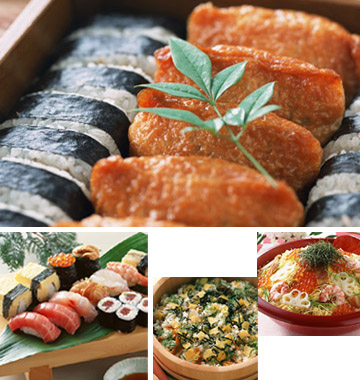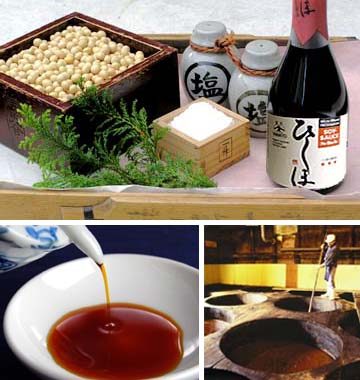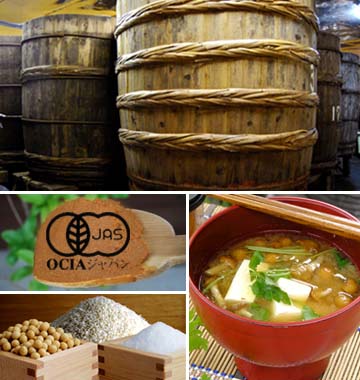![]()
Japanese Cuisines -"Sushi" Basics-
Yamato Soysauce & Miso
There are various styles of sushi.
The original concept of sushi is, with the aid of starchy rice, to preserve those of protein-rich foods, fresh water fish and fresh meat. Natural fermentation take place when fish is kept a long with millet or rice, starchy grains, and the generated lactic acid prevents from rotting. Sushi has various styles such as Nigiri(hand pressed)-sushi, Sushi Roll, Pressed Sushi, Chirashi-sushi, Nare(fermented)-sushi, Mushi(steamed)- sushi, Inari(wrapped in deep fried soy bean curd)-sushi and Chakin(wrapped in egg crepe)-sushi. Recipes and flavors vary from one locality to another. Sushi rice is flavored with vinegar, salt, sugar and so on.
Why do we use soy sauce when we eat sushi?
All the raw materials of soy sauce such as salt, acid of lactic bacteria and alcohol of yeast have germicidal power, so germicidal capacity of soy sauce is considerable. Raw fish is used for sushi, so dipping in soy sauce is not only for us to relish but also to kill bacteria. Just a little soy sauce is enough to enjoy eating sushi. "Zuke" is a kind of sushi topping. "Zuke" is tuna flesh confitted in soy sauce. By being confitted in soy sauce, the fish is preserved and palatability is improved. If you do not like raw tuna, you should try "Zuke". We are sure you will understand the daintiness of soy sauce.
Taste and eye appeal of Sushi are a certain type of art form.
Some conditions such as the shapes of toppings, balance of the toppings and the rice, the shape and softness of the rice ball and so on decide the taste of the sushi. The difference between good sushi and bad sushi is very big.
Each sushi topping is very small but with variously precooked and filleted by the skillful handling of a kitchen knife. Through a lot of steps and after being them handshaped with rice, a piece of sushi finally comes along. It seems like a simple dish, but we all can enjoy the various taste and textures of sushi.
ページのトップへもどる

Ingredients of soy sauce are simple – only needs soy beans, wheat and salt.
Soy sauce is an indispensable seasoning to Japanese cuisines.
It contains saltiness, Umami, sourness and sweetness together. Also,
just like miso, soy sauce is a fermented seasoning peculiar to Japan.
Miso and Soy sauce are mainly made from soy beans and contain "Umami"
of glutamine acid. Japanese climate is suitable to produce vegetable
fermented foods. Sake, Japanese pickles and natto (fermented soy beans)
are also ones of the fermented foods.
Temperature, humidity and Moromi stirring process are important factors.
Firstly, the equal volume of steamed soybeans and crushed roasted wheat are mixed, then purely cultured seed Koji-mold are added to the mixture. Nextly, Salt, the third and last ingredient, is dissolved into water, which is then mixed with Koji and poured into a large wooden tank. Experts at the factory stir Moromi with fresh air in order to promote fermentation. Flavor, color and aroma of soy sauce are generated and improved slowly during this time. This is called aging. Temperature and humidity are important factors to produce good soy sauce during the process of aging.
Our manufacturing method is the one that called Slow Food. We invest a good deal of time and effort to produce good products.
When you taste the high quality Moromi, its rich flavor spreads all over your mouth. It is strong and rich aroma that won't easily disappear. After stirring Moromi for about a year and the aging of Moromi is completed, Moromi is squeezed into soy sauce. Only naturally brewed high quality Moromi that aged without haste can create fine aroma and subtle flavor.
Soy sauce goes well with various foods such as vegetables, fish and meat and it can be used for any ways of cooking: grilling, boiling, steaming, dipping and just pouring. Try it!
ページのトップへもどる

We use native organic soybeans and rice.
Organic Miso received the accreditation of OCIA. Miso manufacturing
needs a lot of time and manpower for selecting the ingredients, for
fermenting and aging. You can't easily find JAS organic accredited
soybeans and rice among the domestic products. We use organic rice
and soybeans grown in Ishikawa prefecture for the ingredients.
In the most appropriate environment, our Moromi (mash of unmatured
soy sauce) is aged in 2,880 liters big wooden tank (one tank can contain approximately
3 tons of Miso). Microorganisms that serve important roles keep working in
the tank. After a long time aging as long as a year, Miso for the product
is finally ready. This wooden big tank help to combine the cycle of the natural
temperature change depends on four seasons and the cycle of aging. Thus, these
tanks are suitable for the production of naturally aged and aromatic Miso.
Natural aging using these wooden tank is the fruit of the achievements of
the ancient wisdom.
Our products are produced by the cooperation of growers, our company and customers.
Naturally brewed and aged Miso is a powerful Miso having an unique aroma and a rich flavor (Umami). It contains active lactic acid bacteria, so it is a high quality Miso that goes well with the taste of seasonal food and fish. Also, it dissolves well in soup stock. Curiously, the flavor is not altered when boiled again. So you can enjoy the soup again the next day. It may be because of the fundamental power of long time aging.
ページのトップへもどる
